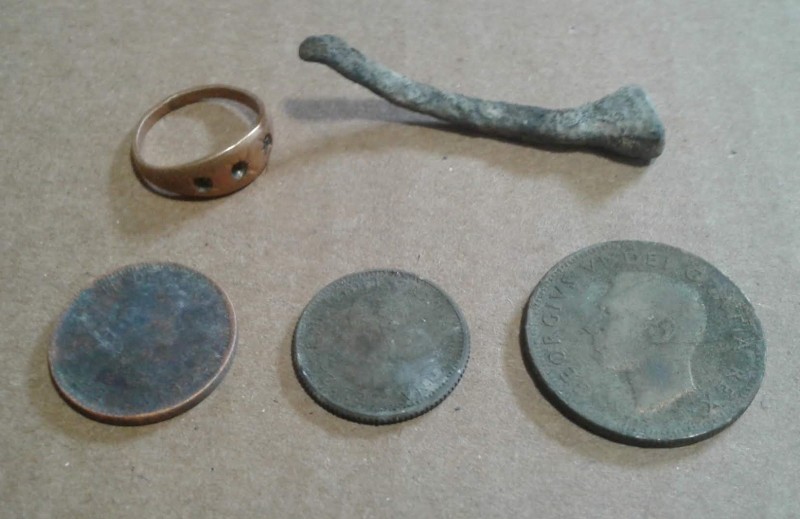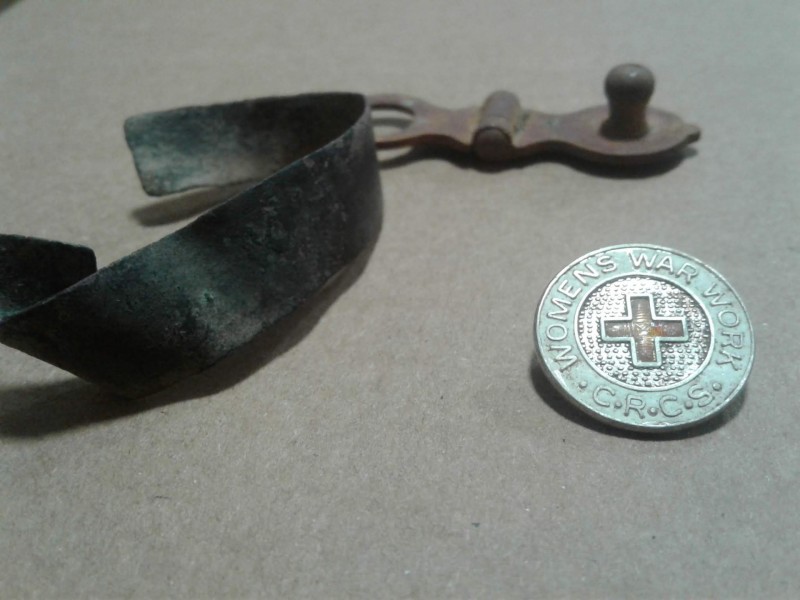-
Posts
530 -
Joined
-
Last visited
Content Type
Forums
Detector Prospector Home
Detector Database
Downloads
Everything posted by Alluminati
-
What does the rusty end on the left look like, it could be a watch winder.
-

Grey Ghost Headphones For Equinox Available Soon?
Alluminati replied to Darwoody's topic in Minelab Equinox Forum
This is the response I was going to write yesterday, but decided to give the manufacturer the benefit of the doubt, having not actually looked at them myself. Seeing the pictures that Edsped posted is enough to confirm my suspicions. Dirt cheap components literally glued into some $10 lawnmower earmuffs. "Based on some comments in this thread I might be able to extrapolate what is wrong with the GG you guys had. A touchy volume control means they used the wrong kind of potentiometer. You need logarithmic for audio use, not linear. Even when the volume control is on full, it will still attenuate the signal as it is still a resistor to ground. Using say a 1M ohm potentiometer instead of 100K ohm potentiometer would be better, for example. Lastly the drivers themselves. It takes twice the amplifier power for every 3db loss in speaker efficiency. High efficiency costs more. It sounds like they are poorly built, or the components were poorly selected, or a combination of both. Given the price of them, they could have spent an hour to choose the right components, or spend the money on nicer components. There isn't a consumer electronic device out there that has a potentially higher profit margin than headphones, so no excuses. Cheap headphone speakers start at about 10 cents, so it's not out of line to expect something a little better for the price, IMO of course." -
Another vote for the 600. Since it is a slightly inexpensive version of a modern classic which you already own, it's an easy choice. It would make a great backup for you as well. On the other hand, if you did want to get something different, I would look around for a deal on a Deus. It's light and pretty bad-ass in it's own right. With the Equinox out now and a new Deus coil due in the fall, the market is a soft as I've ever seen it on Deus.
-
I find they work there was loose in a matter of minutes. If I really jam them in there, it hurts the ears. Another big reason is they can be really painful if you get the wire caught on something and rip the buds from your ears. There are a million different earbuds out there, maybe there is a pair for me. On the other hand the audio response us usually a littler flatter with the bigger drivers in the headphones vs the buds, generally speaking of course.
-
It looks like it might be Hebrew?
-

Found My 3rd Half Dollar Ever Today!
Alluminati replied to foreverteachable's topic in Metal Detecting For Coins & Relics
You sure get some nice big coins. That button with the leaves is really nice. Too bad about the spoon being broken, its really old. I wasn't much of a hunter but I was an avid fisherman, I stopped due to conservation concerns. Metal detecting has replaced those activities in a big way. I love detecting a lot more then I did hunting and fishing. Metal detecting has more freedom and less restrictions for the time being. Even with a top shelf detector it's still a relatively cheap hobby. There are a lot of variables as to why you may not have found much in 1997, who knows, it doesn't really matter much the main thing is that you are on to it now and will most likely be able to maintain this success more or less moving forward assuming you get the coil over some different ground every once in a while. -

Wobbly Shaft Quick Fix - Equinox 600 / 800
Alluminati replied to Alluminati's topic in Minelab Equinox Forum
Ah, yes twisting would be annoying. I wish the factory shaft did allow for some actual intentional rotation, I would tip the handle inward a bit rather then straight up and down. Truth be told I love this machine so much that the shaft could fold in half like a cheap AM antenna and I wouldn't be upset lololololol. Best of luck, it will be interesting to see what they do for you. -
It could be useful. I have been trying to figure some sort of a manual separate for target rich areas. The key is that those targets lay on a more or less two dimensional layer right on the clay, so I would need the ability to scrap the surface of the clay. Actually my plan kind of evolved into using magnets to remove the iron, leaving the non-ferrous behind for the detector.
-
Right, aftermarket is a good option, I forgot. I found my self really liking the WM-08 module because the WM-80 headphones are way too hot for summertime land use. I've been using the blue wired Deus back-phones with the WM-08 module, modified to have the wire just long enough for the module to sit in my pocket. I also removed the volume control as the Equinox has one already. This is even more comfortable the the Wireless Deus WS4 setup because I don't have the weight of the puck on my head, as light as it is. Though to be fair I could stick the WS4 puck in my pocket with the adapter in effect doing the same, however the thought never occurred to me at the time. The WM-08 module is also faster, about twice as fast as the aptX™ headphones however I can't say that I've noticed a difference yet, I only did a few early hunts with the headphones so too early to tell. Maybe when I switch to the WM-80 headphones in the cooler weather I may notice a slight lag but for now it may be reaching the point of diminishing returns, having after market aptX™ headphones may be the way to go, especially if you can find a cooler on-ear or even a earbud solution. I can't wear earbuds but the seem to work OK for some.
-
For a pulse machine short delay, small coil and a fast decaying coil will get you the smallest nuggets deepest. (Low conductors) Adjust these three parameters as a compromise. Other metals can be detected easier with a longer delay, coil decay can be relaxed somewhat and target size is still more or less tied to coil size. (Though a shorter delay will increase sensitivity to the smaller low conductors for a given coil size.)
-
OK 2 things to consider. That extra nudge in recovery speed will make it a touch easier for setting up "sifter" type programs. Who doesn't want multi freq with deus speed? The second is the wireless headphones and wireless module that come with the 800. Both are very nice items and pretty expensive to buy them separately. If neither one of those things is important to you then take a closer look at the 600.
-
Typical VLF induction balance detectors discriminate on a conductivity scale. You can google various "resistivity chart" to see the metals displayed in order and to get an idea of how similar they are, conductivity wise. This assumes all samples are the same size, typically coin sized. Regardless if the detector has a scale of 50 or 100 for conductivity it will always be silver at the highest and small foil right above iron. Certain detectors like the CTX-3030 and the ETrac also display a "Fe" number. Basically this number tells you how inductive a target is, (How magnetic it is, or it's inductive it is for a non-ferrous metal) This gives you an extra indication if its a deep piece of iron or not, an iron false will usually have a high Fe number. (Dropped cursor on the quick-mask screen) As far as the actual depths a certain machine will detect a certain target, will depend on what the target is and the operating frequency, assuming everything else is equal. Low frequencies excite high conductors, high frequencies excite low conductors however beware target plots on a bell curve. While a low frequency is good for a silver coin, a high frequency may be better due to increased sensitivity to small objects. That is why I say it assumes all targets are the same size comparatively speaking. Another factor is rings. You can take a ring that reads a 75 out of 100, cut it and the number will drop to 30. This is due to the Foucault currents induced by moving the coil over the ring. Here again, the conductivity scale is relative, assuming all rings are the same size.
-
Ah yes, the Andrea Doria.
-
The Equinox got wet for the first time today, it survived and will be without a doubt my primary water detector. I can do 80% of the area I want to do without needing the waterproof headphones, which is kinda nice. The beaches are fairly well sanded in here right now, but I know where to look for a few spots of clay. Things are going to get real interesting this fall when the mighty winds shift. Pictured are the older coins. A 1957 Penny, 1959 silver dime and a 1952 silver quarter. Not a bad bit of change considering I only found 5 coins total. Also a brass ring and a nail that might be from a horseshoe.
-
A tape measure would make sense, I agree. Thanks.
-

Just Discovered Lidar. Amazing Insight Into Old Sites
Alluminati replied to Andy2640's topic in Minelab Equinox Forum
My county is doing a LIDAR survey this year I believe. As far as I can tell the point clouds should be available for download when it's done. -

Lobo ST In Ground Depth Questions Coins And Gold
Alluminati replied to kd7ura's topic in Compass, D-Tex, Tesoro, Etc.
Right on. Are you able to tune your Lobos yourself? -
Shown here with some other high conductors from tonight's outing. I found this with the Equinox at a site that is no stranger to a FBS or two. I'm not sure what the thing in the back is, any ideas? It says "50 feet" on it, I'm thinking it could be from a fishing reel. The black copper band, I don't know what it is, but it has characteristics of native jewelry fashioned from colonial metals that I have found around here in the past. With this site, if you can't ID it you keep it, nothing goes in the garbage unless I'm sure what it is. Last but not least is the Sterling WWII Red Cross pin. "Womens War Work C.R.C.S." (Canadian Red Cross Society) There was a war hospital just across the water from this location, so I have a hunch this may have something to do with that lol. It's kind of a cool find because up until tonight the only evidence left of the hospital existing that I'm aware of is in the form of black and white images, now I have a cool relic that I can hold in my hand.
-
Yes common gold alloy reads from just above iron, to around 2/3rds up the scale. The point I was making was to disassociate the performance of a mostly copper 5 cent to the performance of the machine on gold. The TID does nothing to tell you if you can hit a target at an inch or a foot. Correct? Older machines were hotter on high conductors and lack the resolution to disc very well close to iron. The fact that people use a nickle-clad dime as a pseudo silver dime demonstrates my point, the nickle in your coins isn't nickle enough to call it nickle. If you want to use the TID of an US copper nickle as numerical benchmark, no harm in that. However using one to test nickle or gold performance is very flawed. Come to Canada you guys will really understand what a nickle really is. Pulling a REAL nickle coin from 9" deep requires the same equipment you would use to pull a 9" deep high alloy gold ring. Having a machine that smacks a copper-nickle isn't it. Having a machine that can ID nickle well despite it being magnetic, is the same machine that can ID gold well close to iron in the ground and electrical phase. Weather or not this appears off topic to some, I think it's important noting the difference. The technology plays a big part in the enthusiasm and vigor one might have towards chasing a particular target. It plays a bigger part in their perception of what is actually in the ground.
-
The very first line the OP posted was about a gold thread was it not? Do you not see the correlation between skipping prime gold numbers in lieu low hanging high conductors? Isn't the reason most dig silver is because it is easier? Think about it, you dinn't even have zinc pennies until 1983. I've already explained why there is a surplus of low conductors, that is exactly what the OP is asking for. I at least gave the courtesy to talk about the right metal. You're lack of understanding is why you perceive this is being off track.
-

Today Session Lobo 1 5.75dd
Alluminati replied to Rivers rat's topic in Metal Detecting For Coins & Relics
That looks like a great place.



